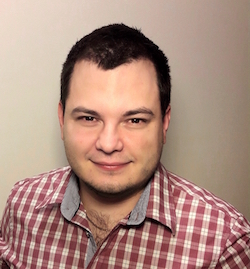Attila Gabor

During the university studies in physics at the Budapest University of Technology, I joint the Process Control Research group of Prof. Katalin M. Hangos at the Computer and Automation Research Institute of the Hungarian Academy of Science. I developed process models based on thermodynamics and thermo-hydraulics for control design and nonlinear analysis.
After my MSc in physics, I started my doctoral studies in Computer Science under the joint supervision of Prof. Katalin Hangos and Prof. Julio Banga at the Marine Research Institute in Vigo, Spain. My main interest become biochemical reaction networks: mathematical modelling of reaction networks, model reduction of biochemical reaction networks and the application of regularization techniques in parameter estimation problems in dynamic biological systems.
Currently, I am a post-doc at Julio Saez-Rodriguez’s group at the Joint Research Center for Computational Biomedicine in Aachen where I am working on single cell modelling.
Research Interests
In the group of Julio Saez-Rodriguez I am developing dynamic mathematical models of cell signalling based on single cell measurements.
Mechanistic models are based on detailed biochemical studies and try to condense the biological knowledge in a dense and well-defined mathematical form. This way, these models have the potential to provide biological insight in the explanation of cell responses to combined perturbation experiments. However, due to complexity of pure mechanistic models (many unknown model parameters and non-measured variables) it is often impossible to calibrate them to scarce data, which results in poor predictive power of these models. On the other hand, data-driven/machine learning methods are great in prediction, but lack the biological interpretation of the model.
My main research interest is the application of semi-mechanistic models to cell responses to single and combined growth factor perturbations. These semi-mechanistic models, for example the logic based dynamic models, combine the biological knowledge reported in the literature, with the flexibility and simplicity of data driven methods, therefore it has the predictive power and also the biological interpretability.
Applying the above models to single cell measurements, we get closer to understand
(1) how the signalling network changes upon treatments,
(2) how combination of treatments affects each other (pathway cross-talks)
(3) how the cell-to-cell variability in the signalling state can result in different response to treatments.
Professional Career
| 2015-present | Post-Doc at the JRC-COMBINE, Aachen, Germany |
Education
| 2012-2015 | Marie Curie Early Stage Researcher, Bioprocess Engineering Group, Vigo, Spain |
| 2011-2012 | Research assistant, Process Control Research Group, MTA SZTAKI, Budapest |
| 2011-2017 | Phd Student of University of Pannonia, Veszprem, Hungary |
| 2009-2011 | MSc in Physics, Budapest University of Technology and Economics, Hungary |
 0000-0002-0776-1182
0000-0002-0776-1182